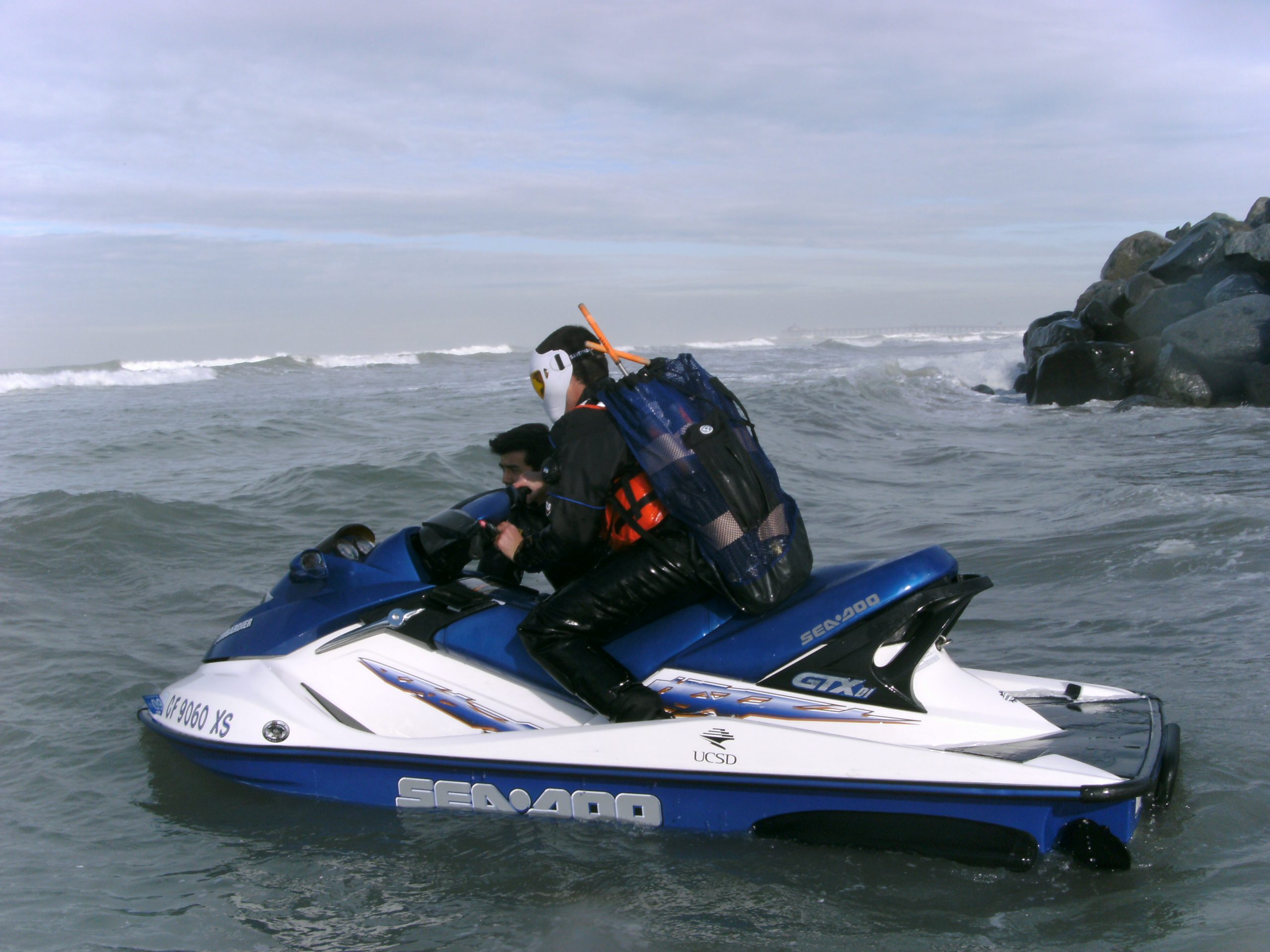
Technology Development and Custom-Made Drifters
The Lagrangian Drifter Laboratory develops custom drifters to fit scientific program requirements.
From 1980 to the 1990s, Peter Niiler and Russ Davis, both scientists at Scripps Institution of Oceanography, conducted extensive research to determine which drifter shapes and drogues would dependably measure circulation at the sea surface, at 15 meters and 35 meters depths, and deeper. This body of research led to the drifter designs that currently support the Global Drifter Program (GDP).
The Lagrangian Drifter Laboratory has the experience and design expertise to incorporate additional sensor packages and communication modalities into these documented drifter and drogue shapes. These custom-made drifters, which are integrated into the global array, support research beyond what the GDP provides, while maintaining consistency with the physics of Lagrangian motion that have been studied and documented so that the platform has a known physical response to the circulation and wave field.
References
Niiler, P.P., R.E. Davis, and H.J. White. 1987. Water-following characteristics of a mixed layer drifter. Deep Sea Research Part A 31:1,867–1,881, https://doi.org/10.1016/0198-0149(87)90060-4.
Niiler, P.P., A.S. Sybrandy, K. Bi, P.M. Poulain, and D. Bitterman. 1995. Measurements of the water-following capability of holey-sock and TRISTAR drifters. Deep Sea Research Part I 42:1,951–1,964, https://doi.org/10.1016/0967-0637(95)00076-3.
Sybrandy, A.L., and P.P. Niiler. 1990. The WOCE/TOGA SVP Lagrangian Drifter Construction Manual. Scripps Institution of Oceanography, University of California San Diego, SIO reference 90-248. La Jolla, California.
EXAMPLE: The River Drifter™
The River Drifter was designed for shallow water applications (>1 m). It collects concurrent measurements of surface currents, three-dimensional velocity profiles beneath the device, water depth, and salinity. There was a need for a Lagrangian drifter that would be able to operate in shallow bodies of water, such as lagoons and estuaries, while also measuring water depth and vertical shear of the three-dimensional velocity underneath. The original design was requested and funded by the Office of Naval Research.
Applications
The River Drifter was used in a study of the fate of a pollution plume in the Tijuana River. The investigators used two River Drifters to characterize variability in the dispersion and final trajectories of the pollution plume. The different behaviors of the two drifters are explained in terms of the local flow dynamics, which are strongly influenced by the seabed morphology, forcing the River Drifters to move in different directions.
Technical Specifications
Go to the River Drifter page to view the technical specifications.
Reference
Postacchini, M., L.R. Centurioni, L. Braasch, M. Brocchini, and D. Vicinanza. 2016. Lagrangian observations of waves and currents from the river drifter. IEEE Journal of Oceanic Engineering 41(1):94–104, https://doi.org/10.1109/JOE.2015.2418171.
EXAMPLE: The Autonomous Drifting Observing Station™
Development of the Autonomous Drifting Ocean Station (ADOS) by the Lagrangian Drifter Laboratory (LDL) was motivated by the need to measure temperature and velocity structure in the ocean’s upper mixed layer. The ADOS surface buoy is connected to a tether that has temperature and pressure sensors spaced every 10 m (or at other selected distances). Because of the tether, the ADOS is not a Lagrangian device and does not follow the water in a true Lagrangian way. The LDL also developed a hybrid ADOS (“ADOS-A”), outfitted with two 400 KHz AquaDop current meters, one looking up and the other down, to measure the properties of large-amplitude internal waves that propagate across the South China Sea (Centurioni, 2010).
The ADOS was then customized to study the properties of the cold wakes behind hurricanes. The cable was outfitted with thermistors, and spacing was determined by the science party that commissioned their development. The surface float measures sea surface temperature, while 10 nodes that measure water pressure and temperature are attached to the cable with equal spacing to 150 m depth. The subsurface nodes use inductive communication technology to send the data through the single-conductor-impregnated steel wire rope combined with a seawater contact that closes the electrical circuit. The surface buoy is identical to the one used for the MiniMet Drifter.
Motivated by the need for these measurements in hurricanes, the LDL customized the ADOS to be air-deployable so they could be dropped before, during, and after the storms.
Applications
The ADOS collects measurements within the upper 200 m of the ocean. ADOSs have been used to measure the ocean’s thermal response to the passage of severe storms, hurricanes, and internal waves, and to measure detailed upper ocean structure, such as during the Salinity Processes in the Upper-ocean Regional Study (SPURS). The ADOS has also been used to study water properties at the terminus of Helheim Glacier in Greenland.
Technical Specifications
Go to the ADOS page to view the technical specifications.
References
Centurioni, L.R. 2010. Observations of large-amplitude nonlinear internal waves from a drifting array: Instruments and methods. Journal of Atmospheric and Oceanic Technology 27:1,711–1,731, https://doi.org/10.1175/2010JTECHO774.1.
D’asaro, E.A., P.G. Black, L.R. Centurioni, Y.-T. Chang, S.S. Chen, R.C. Foster, H.C. Graber, P. Harr, V. Hormann, R.-C. Lien, I.-I. Lin, T.B. Sanford, T.-Y. Tang, and C.-C. Wu. 2014. Impact Of typhoons on the ocean in the Pacific. Bulletin of the American Meteorological Society 95(9):1,405–1,418, https://doi.org/10.1175/BAMS-D-12-00104.1.
D’Asaro, E., P. Black, L. Centurioni, P. Harr, S. Jayne, I.-I. Lin, C. Lee, J. Morzel, R. Mrvaljevic, P.P. Niiler, L. Rainville, T. Sanford, and T.Y. Tang. 2011. Typhoon-ocean interaction in the western North Pacific: Part 1. Oceanography 24(4):24–31, http://dx.doi.org/10.5670/oceanog.2011.91.
Hormann, V., L.R. Centurioni, L. Rainville, C.M. Lee, and L.J. Braasch. 2014. Response of upper ocean currents to Typhoon Fanapi. Geophysical Research Letters 41:3,995–4,003, https://doi.org/10.1002/2014GL060317.


